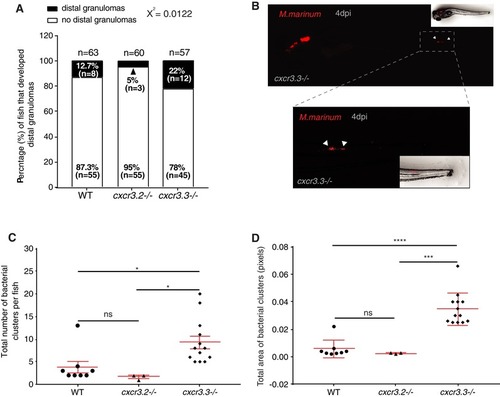
Enhanced motility of cxcr3.3 mutant macrophages facilitates bacterial dissemination. Four days after local infection with 200 CFU of Mm in the hb, cxcr3.3 mutants developed more distal granulomas (22%) than WT (12.7%) and cxcr3.2 mutants (5%), whereas the latter developed fewer than the other 2 groups (A). Embryos from the 3 genotypes were infected at 28 hpf and imaged under the stereo fluorescence microscope (whole body and zoom to the tail) at 4 dpi. Panel B illustrates the imaging process of a representative cxcr3.3 mutant larvae. Cxcr3.3‐depleted larvae developed more distal granulomas per fish (C) and these granulomas were also larger in cxcr3.3 mutants than the other 2 groups, whereas cxcr3.2 mutants showed an opposite trend (D). Graphs show pooled data from 4 independent replicates, each of 12–15 infected larvae per group. The number and size of distal granulomas were determined using the “analyze particle” function in Fiji. A χ2 test was conducted to assess differences in the proportion of larvae that developed distal granulomas within the 3 groups and a one‐way ANOVA to compare the number and size of distal granulomas (ns P > 0.05, *P ≤ 0.05, ***P ≤ 0.001 and ****P ≤ 0.001). Data are shown as mean ± sem
|

